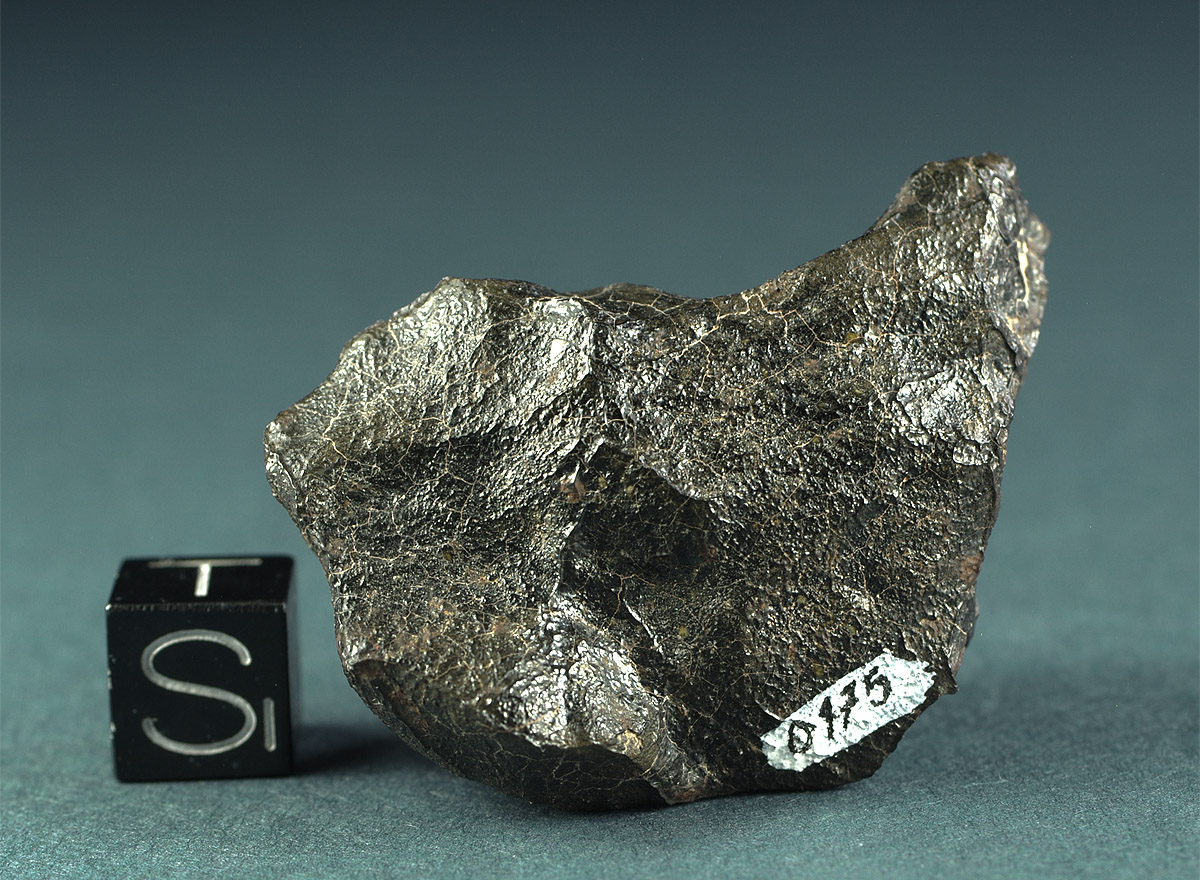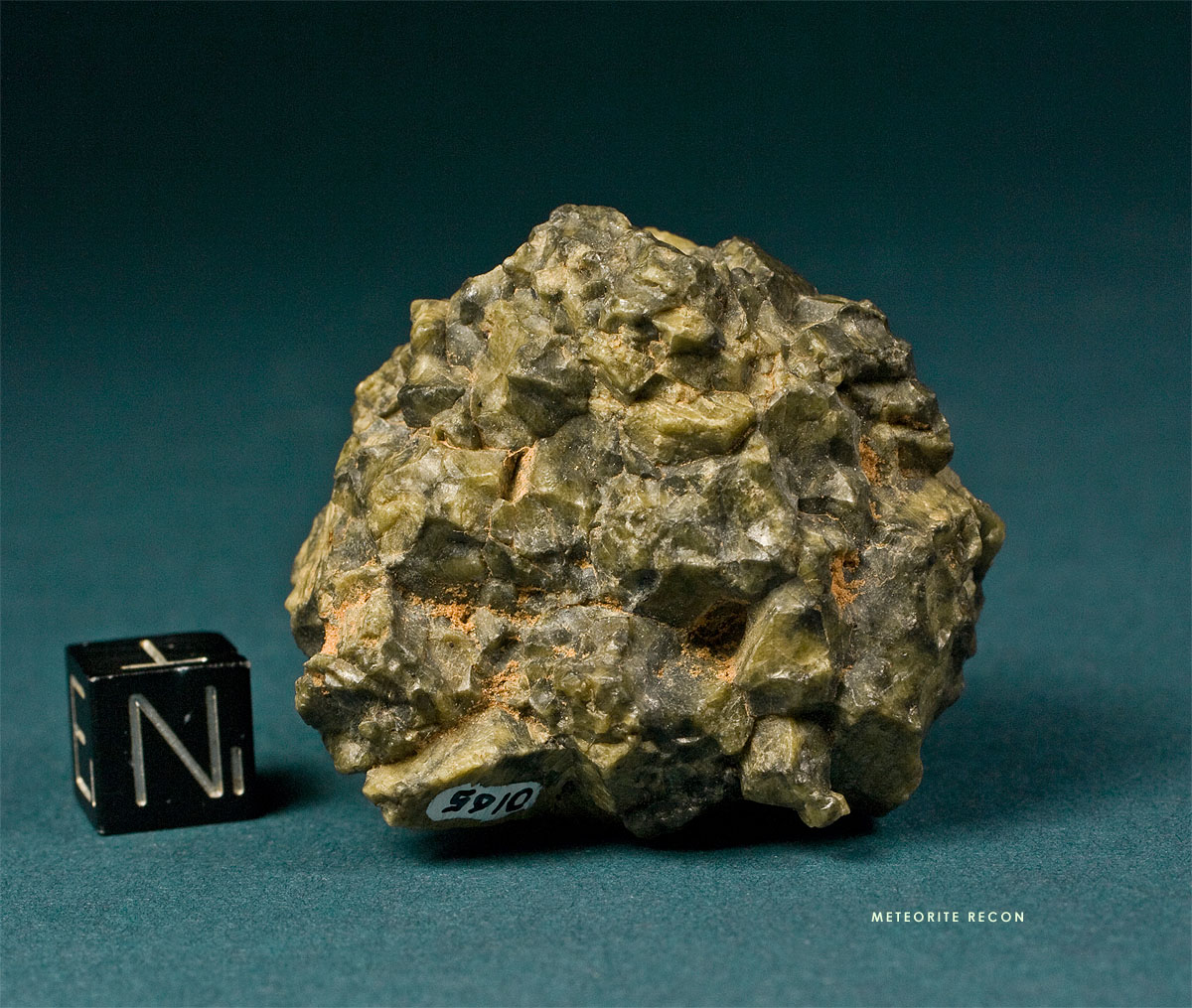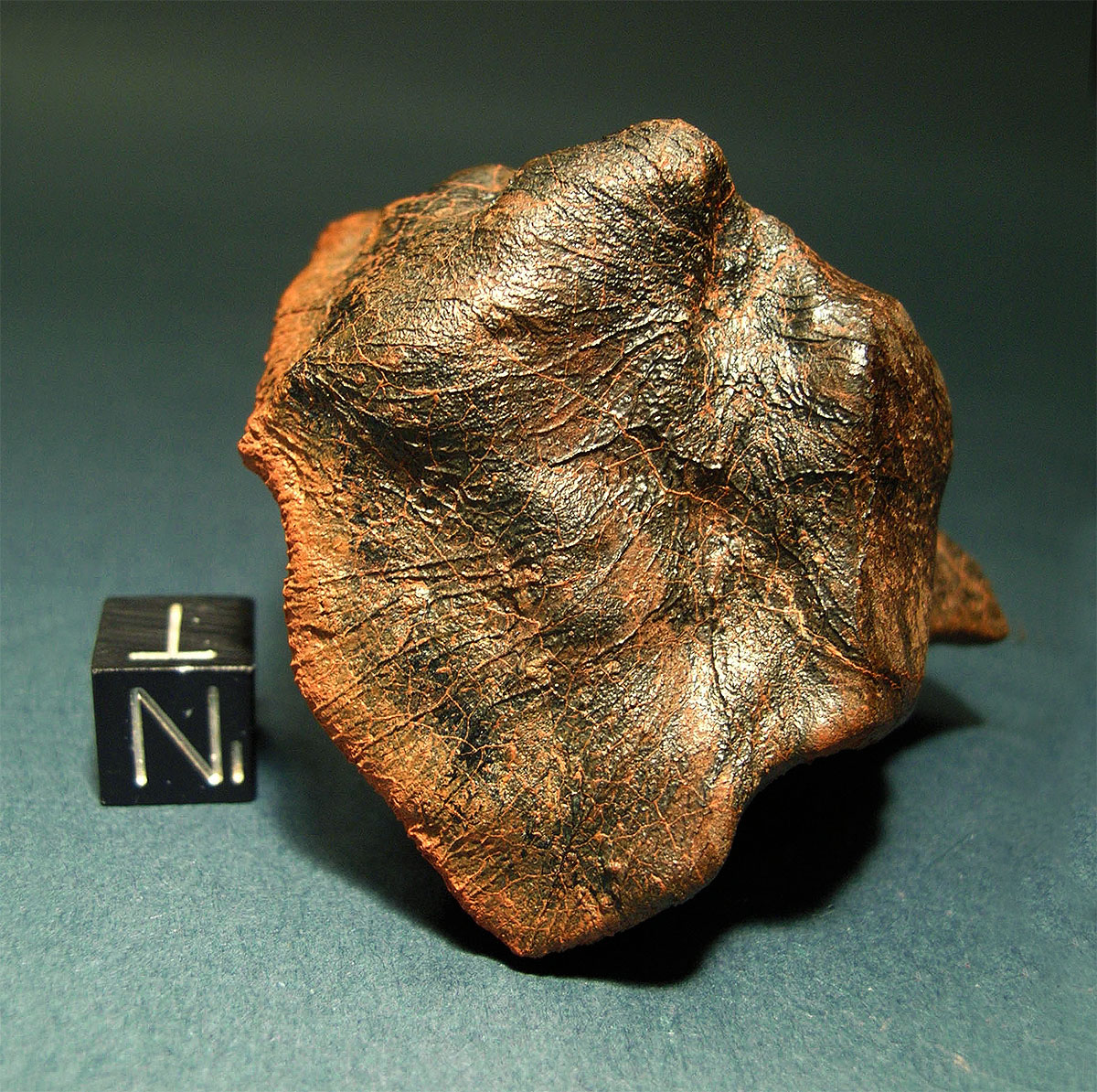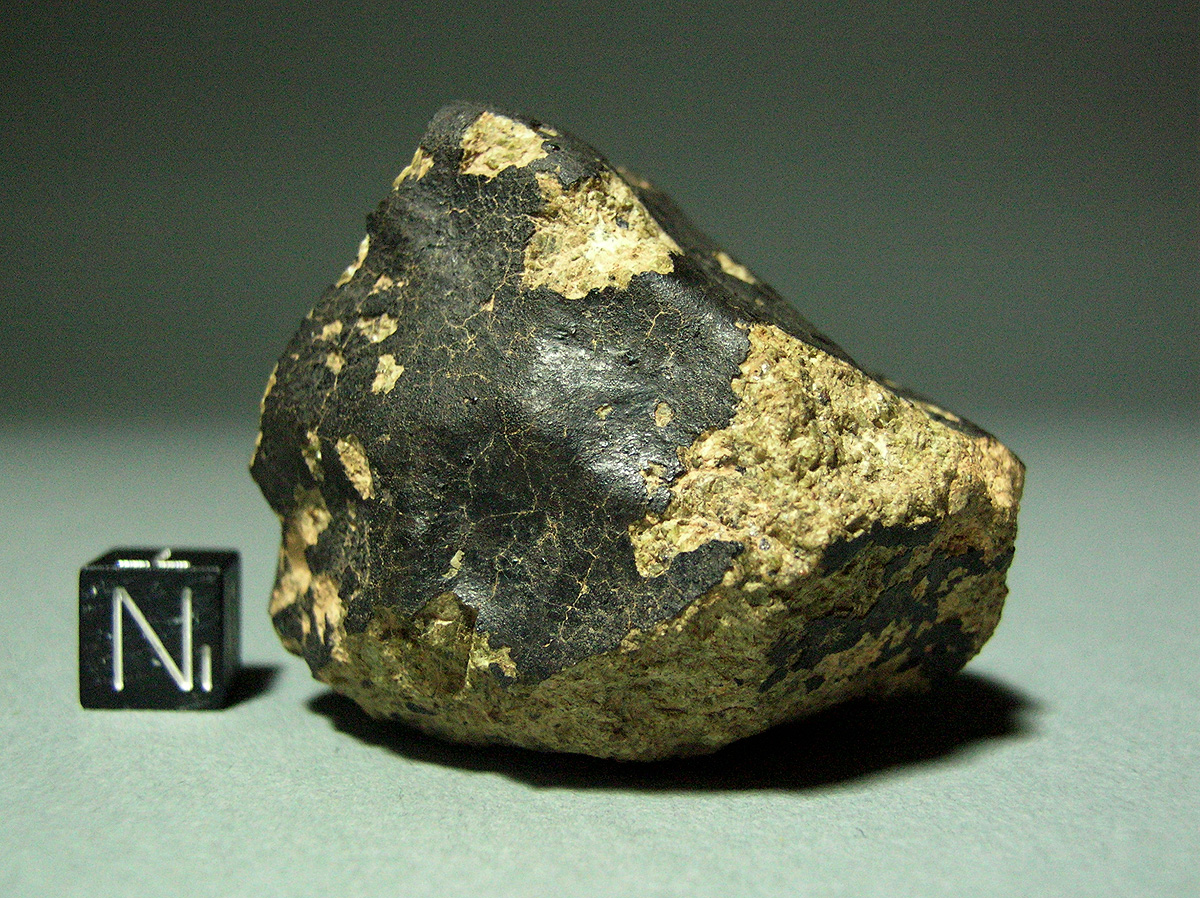Meteorite Recon | Achondrites
Meteorite search expedtions into continental deserts, meteorite features, collection specimens and photography
Meteorites, Meteorite, meteoritic, iron, meteorites, photos, pictures, in situ, strewnfield, strewn field, impact, fall, finds, Meteorite searching
148
archive,tax-portfolio_category,term-achondrites,term-148,eltd-core-1.0.1,ajax_fade,page_not_loaded,,borderland-ver-1.8, vertical_menu_with_scroll,smooth_scroll,paspartu_enabled,paspartu_on_top_fixed,paspartu_on_bottom_fixed,transparent_content,grid_1300,wpb-js-composer js-comp-ver-6.0.3,vc_responsive,elementor-default,elementor-kit-6471

Stone, HED achondrite, olivine diogenite
Agaraktem, Gao, Mali
Find: May 2009
TKW: 2,290 g
Half individual: 463 g
Very fresh diogentite endcut with polished cut surface and smooth black crust preserved in patches. Chromite crytals extending from crust. Obviously paired with Olivine diogenite NWA 5480.
Writeup from MB 101:
History: Four meteorites were discovered by an anonymous finder east of Agaraktem, Mali, in May 2009.
Physical characteristics: Four almost complete individuals totaling 2290 g.
Petrography: (R. Bartoschewitz, Bart) Polycrystalline olivine clusters (~50 vol%) of idiomorphic to hypidiomorphic cystals (<1 mm, average about 0.1 mm) distributed in schlieren-like bands within a matrix of xenolithic to hypidiomorphic pyroxene grains (about 1 mm), with rare intergranular feldspar. Chromite and metal occurs dominantly within pyroxene and olivine grains.
Geochemistry: (R. Bartoschewitz, Bart; P. Appel, B. Mader, Kiel) Pyroxene Fs23.8-25.4Wo2.0-4.4, olivine Fa29.3-30.3, feldspar An76-83Ab1-5. Chromite Al2O3 = 14.4-15.4, TiO2 = 0.9-1.1, MgO = 4.1-4.8; Kamacite Ni = 0.3-1.1, Co = 0.7-0.9 (all in wt%).
Classification: Olivine diogenite, S1, very fresh
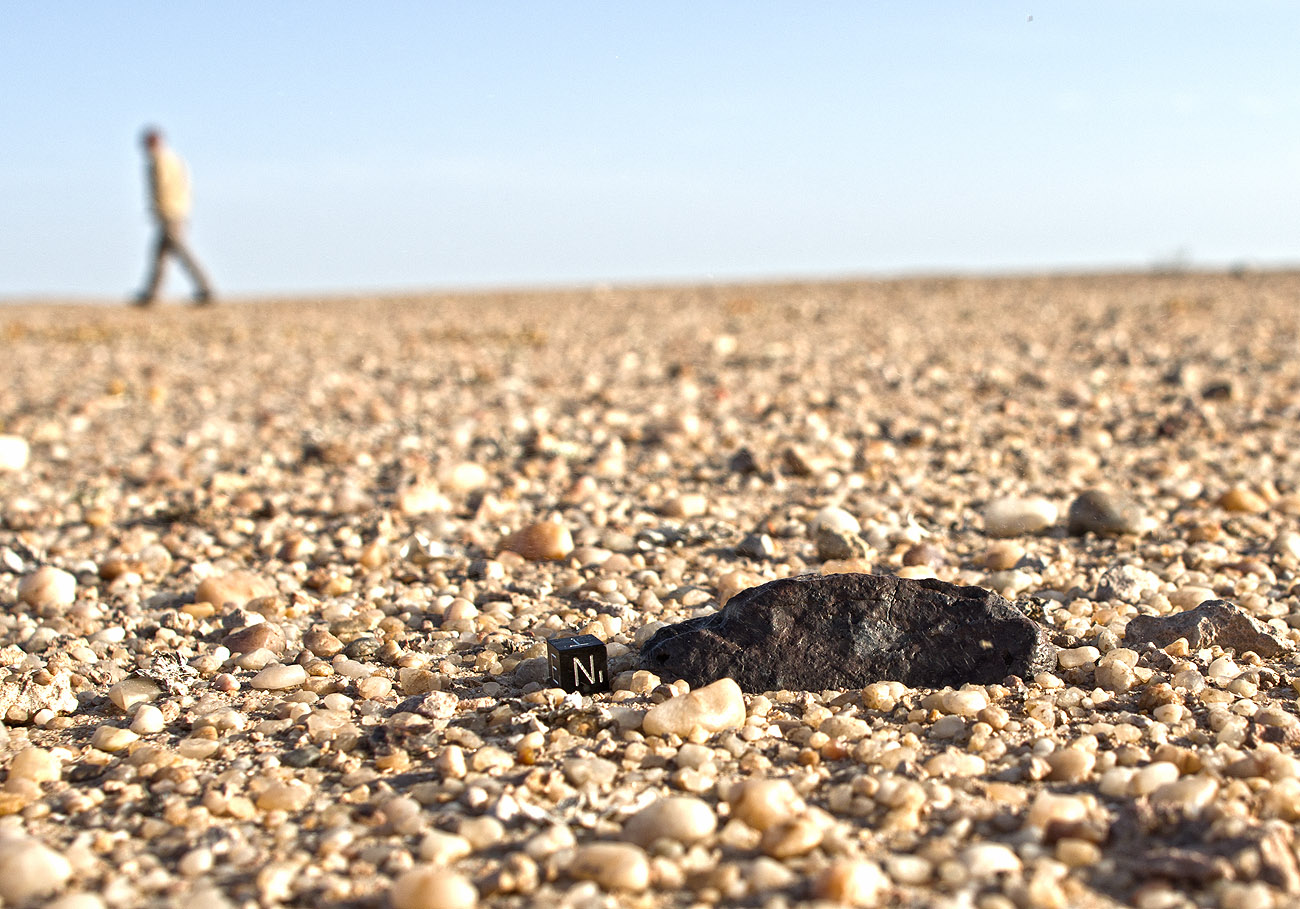
Stone, primitive achondrite, brachinite
Boujdour, South Morocco
Find: April 24, 2013
Finder: S. Buhl, T. Fuellengraben
TKW: 333.4 g
Endcut: 112.10 g
Heavily weathered primitive achondrite found during the 2nd Meteorite Recon expedition in the Bir Aridal DCA. This specimen represents one of only 38 brachinites known worldwide (as of 2015), and the only documented find of this classification in Africa.
History: Found by Svend Buhl and Tomas Fuellengraben on April 24, 2013
Physical characteristics: A single brownish, oxidized stone.
Petrography: Optical microscope examination of a polished section reveals an equilibrated texture with triple junctions. Main mineral is olivine (grain size 400 μm). Accessory plagioclase (grain size 500 μm) and pyroxene (grain size 150-400 μm). Presence of Ca-phosphate and chromite.
Geochemistry: Olivine Fa=28.6±0.7 (n=14), FeO/MnO=50.0±1.8; Augite Fs=10.6±0.2 (n=3) Wo=43.7±0.2 (n=3), FeO/MnO=28.0±2.1, Al2O3=0.6 wt%; Plagioclase Ab82.2 O1.4 An16.34. Oxygen isotopic composition (J. Gattacceca, C. Sonzogni, CEREGE) δ17O=3.10 per mil, δ18O=6.17 per mil, Δ17O=-0.11 per mil (analysis of 1.5 mg of hand-picked olivine grains after acid washing of a 200 mg powdered sample, TFL slope=0.52).
Classification: Based on petrography, geochemistry and oxygen isotopic composition this is a primitive achondrite (brachinite).
Specimens: 26 g at FSAC, 14 g at CEREGE. Main mass with Svend Buhl.
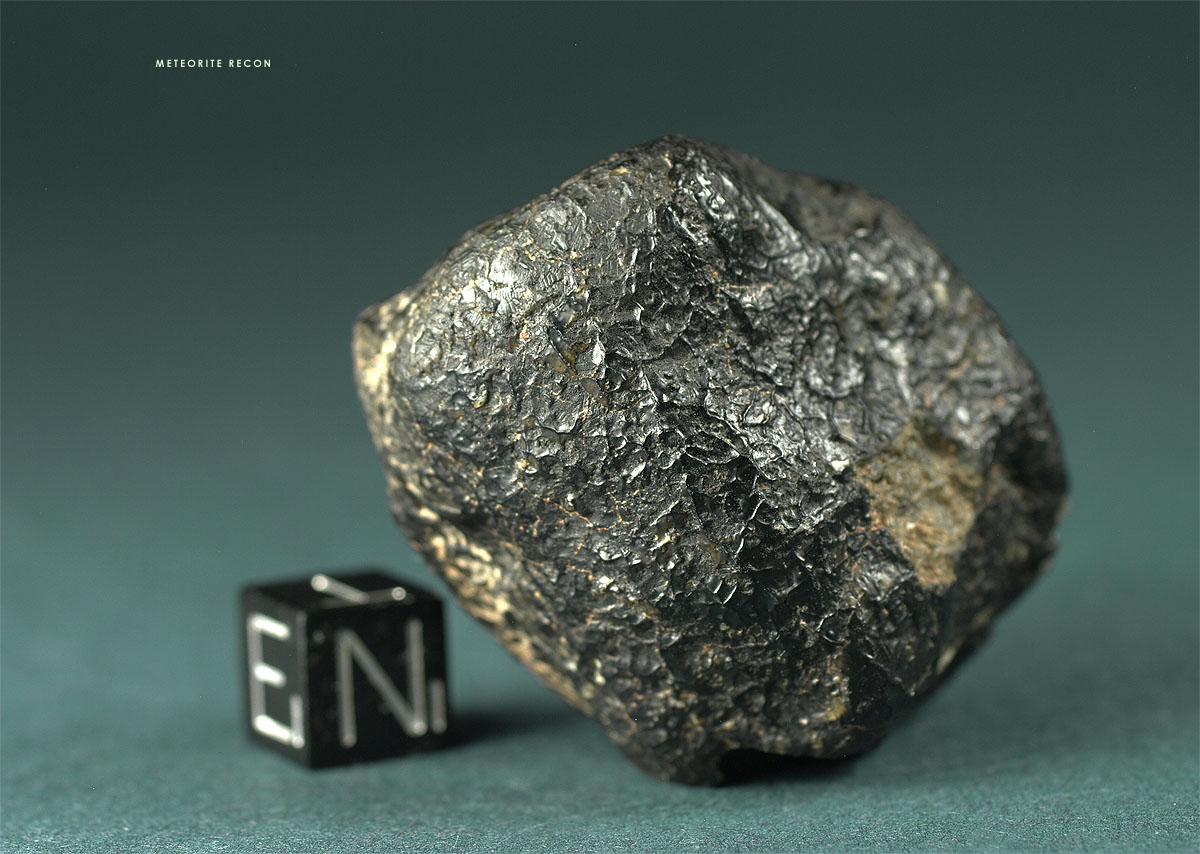
HED-achondrite, eucrite
Purchased from a dealer in Ouzarzate, Feb 2009
TKW: 48.0 g
Individual: 48.0 g
This meteorite was purchased as a “special stone” in February 2009 from a Moroccan mineral dealer. Neither the precise find location nor the name of the finder is known. It was said to be found in the Morrocan Sahara. The meteorite has the size and shape of a fig and shows a glossy black fusion crust as well as a lightly oriented shape with a convex front and a concave rear surface. The dimensions are 4.40 x 3.65 x 2.75 cm, the weight of the stone is 48.0 g.
On two spots the fusion crust is missing, first, on a 7 x 7 mm chip, that probably goes back to the time of the fall as it already shows a darkened matrix coated with forming caliche. The second damage is a missing corner of 14 x 12 mm that was appearently cut out of the meteorite with a hand saw . Beginning light red caliche deposits are marking the meteorite’s lower portion of the broadest surface, which was embedded in a light red soil with clay constituents. The overall appearance of the meteorite is very fresh.
Due to a burred texture composed of delicate spines and ridges the glossy black fresh fusion crust gives the meteorite a crumpled appearence, much like a dried prune. Several patches of the fusion crust show a vesicular structure in the sub milimeter range. Also, Obviously the meteorite is composed of inhomogenous constituents with differing melting points, which lead to a granular and uneven ablation of its surface.
The fusion crust displays two noteworthy features. First, glass pockets can be seen solidified in various stages of melting, from clear and transparent to coffee and honey colored and semi opaque to a full opaque glossy black. The second characteristic of the fusion crust is the display of grain boundaries, apparently due to selective ablation of different mineral components. The grain boundaries are visible in the shape of parallel structures reaching lenghts of up to 4 mm. These parallel structures seem to represent underlying coarse grains with barred crystallization patterns. On several spots glass pockets are seperating these grains.
As can be seen in the image of the cut section below, the meteorite appears to consist mainly of a pyroxenes and feldspathic glass (originally plagioclase). In fact a large percentage of the matrix shows grains of transparent and semi transparent glass. Under the microscope these glasses often reveal Vesicular pockets with trapped melt inclusions indicating a shock event on the motherbody. One other striking feature of the matrix is the relatively coarse grain size indicating a cooling at a relatively slow rate.
Under magnification, the cut section prepared for classification reveals the parallel orientation of the lammellae zoning within the grain structure. As the write up from NWA 5787 in Met.Bull. No. 98 points out, these features bear witness to a strong shock event on the meteorite’s mother body: “The plagioclase consists of multiple domains of subparallel, ribbon-like microcrystals, suggestive of quenching from shock melt (as in some shergottites)”.
The cut surface detail shown above resembles a rather porous section of the meteorite. Glass grains and parallel lamellae are visible. As can be expected no general orientation of the parallel crystallization pattern is obvious, each barred grain shows a different allignment of its orientation axis.
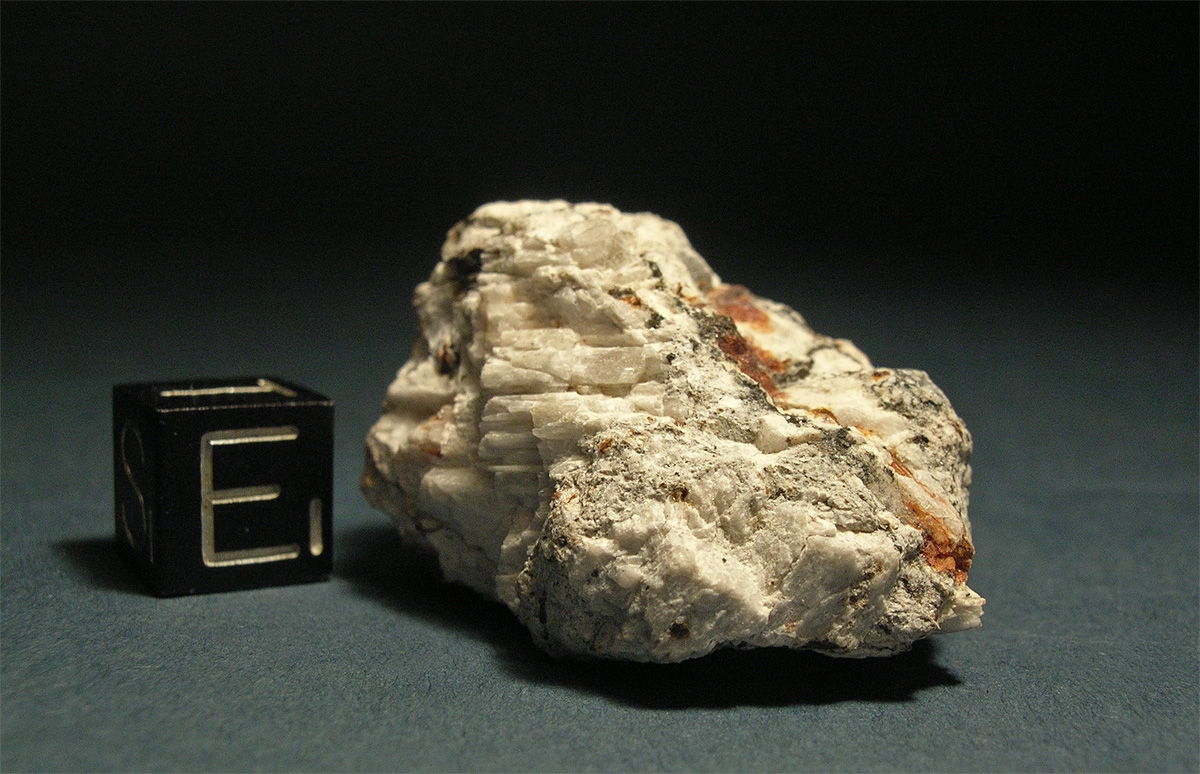
Stone, achondrite, aubrite, AUB
Norton County, Kansas, USA
Fall: February 18, 1948, 04:00 p.m.
TKW: 1.1 MT
Fragment 19.50 g
Fragment from the Lincoln La Paz collection. At about 4 p.m. on February 18, 1948, hundreds of people witnessed a brilliant fireball in the clear afternoon skies above Colorado, Kansas, and Nebraska. Several people heard loud explosions, followed by a roaring sound like the noise of a jet engine. In the smoke train behind the fireball, puffs of smoke appeared where the large meteorite that was streaking across the sky broke apart in smaller pieces. In the following days and months, hundreds of stones were recovered from a large area on the Kansas / Nebraska border, in Furnas County, Nebraska and Norton County, Kansas. The meteorite became known as the Norton County meteorite.
The 2nd collection specimen (B-23.1) is a fragment of 38.24 g. According to the then practised conservation method by the Institute of Meteoritics of the University of New Mexico, the curator coated the fragile Meteorite with clear laquer.
Collection specimen # B-23.2 is a pristine Fragment of 27.30 g, also from the University of New Mexico, and bears the original inventory number # N 533.
Stone, achondrite, Ca-rich, metal-rich eucrite, AEUC
Camel Donga, Nullabor Plain, Western Australia
Find: January 1984
TKW: >7.6 kg
Individual: 34.60 g
Irregular shaped individual with pristine glassy crust, delicate contraction cracks and flowlines on all surfaces. 12 stones were found in 1984 and 1985 within a radius of 1 km by Mrs. J.C. Campbell, B. Mason and W H. Cleverly. Judged by the lack of patina the Camel Donga meteorites were discovered shortly after their fall. However, as no eye wittnesses could be identified the meteorite was classified as a find. Highly aesthetic specimen,
Stone, diogenite achondrite, ADIO
Foum Tatahouine, Tunesia
Fall: June 27, 1931, 01:30 hrs
TKW: 12 kg
Fragment 72.50 g
Very rare monomict Ca-poor diogenite. Witnessed fall from June 1931. Tatahouine exploded at the end of the cold flight into a cloud of fragments with only a handful exceeding 39 grams in weight. This golfball-sized specimen has still Tunesian soil adherent.
Stone, achondrite, eucrite, monomict, AEUC-M
Jundee Station track, Wiluna District, Western Australia
Fall: October 1960
TKW: >100 kg
Individual 77.90 gm
At 1:00pm in mid October, 1960 the two workmen opening a cattle gate in the boundary fence along the Millbillillie – Jundee Station track were struck by the sight of blazing fireball descending from the sky with a thunderous sound. But it was not until 1970 that the first meteorite was found. The specimen has the shape of a twin cone with two apexes and a flat trailing edge. Flowlines run from the twin tops towards the edge to the rear making the complete meteorite appear distinctly streamlined from all sides. These flowlines culminate in a number of spikes protruding from the thick rollover lip encircling the trailing side. The two apexes are separated by a deep gorge melted into the monomict eucrite material.
Achondrite, diogenite, ADIO
Outat el Hadj, Morocco
Find: 2007
TKW: 232.60 g
Individual 119.00 g
Two stones of this Johnstown-like diogenite were found near the village of Outat el Hadj in Morocco by Mr. Abdessmad in 2007. One more stone of 61.10 g was found in the same location in 2008. The meteorites show large (>11 mm) orthopyroxenes and a fresh crust with some spalling or beginning desert etch, as well as remnant flow lines. In the Meteoritical Bulletin data base this meteorites hibernates in the “provisonal” state ever since its classification in 2009.
Stone, achondrite, diogenite (ADIO)
Gnagna, Bilanga, Burkina Faso
Fall: October 27, 1999, 10:30 hrs
TKW: >25 kg
Individual: 58.01 g
“After a widely witnessed shower, at least 25 kg of meteorites with fresh black fusion crust were collected, comprising many stones. Pieces are reported to have fallen in the villages of Bilanga-Yanga and Gomponsago” (MetBul No. 84). Many masses including the oriented 7.5kg main mass displayed flow lines, some specimens showed dark shock veining. Bilanga is a unique magnesium-rich and calcium-poor diogenitic breccia and one of only 11 witnessed falls of a digenite meteorite. As can be seen in the image above the meteorite shows a fresh shiny black fusion crust coating a bright white matrix with a tint of green. Large orthopyroxene clasts are visible to the unaided eye.
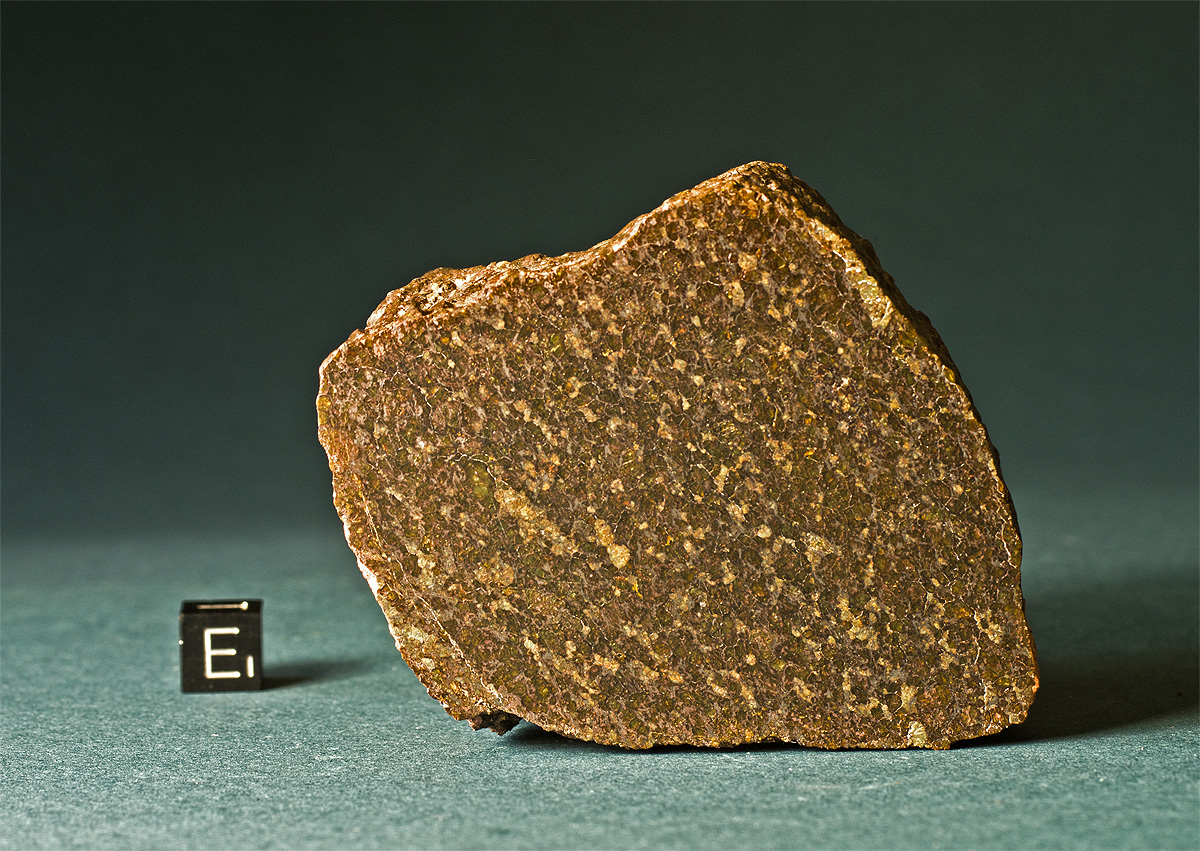
Stone, achondrite, ureilite, AUR
Nouadhibou, Mauritania
Find: October 2012
TKW: 1,200 g (one piece)
Endcut: 613.5 g
Half individual of the ureilite NWA 8168. The sample has one cut surfaces polished to 1500 grit. The original surface shows patches of fusion crust. This is the write up from Meteoritical Bulletin 104:
History: Discovered by local people in the NW area of Mauritania in 2012, purchased in Nouadhibou in 2012 Oct.
Physical characteristics: (R. Bartoschewitz, Bart) One brown fragment of 1200 g. Saw cut shows brown close packed grains. Magnetic susceptibility log χ (× 10-9 m3/kg) = 4.48.
Petrography: (R. Bartoschewitz, Bart) Microprobe examination of a thin section shows olivine and pyroxene grains with triple junctions, grain size 0.5-6 mm. Grain boundaries occupied with graphite and metal. Graphite occurs as elongated areas up to 2 × 7 mm.
Geochemistry: (R. Bartoschewitz, Bart, P. Appel and B. Mader, Kiel) Olivine: Fa21.0±2.0 (Fa14.7-22.1; Cr2O3=0.6-0.7 wt.%; Fe/Mn=44, n=15). Ca-poor pyroxene: Fs7.0 (n=1). Ca-rich pyroxene: Fs15En72Wo13 (n=26). Kamacite: Ni=5.0, Co=0.35, Si<0.3 wt.% (n=6).








